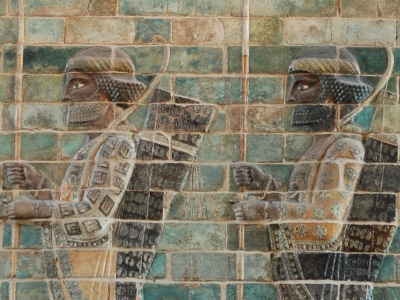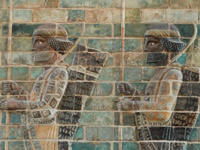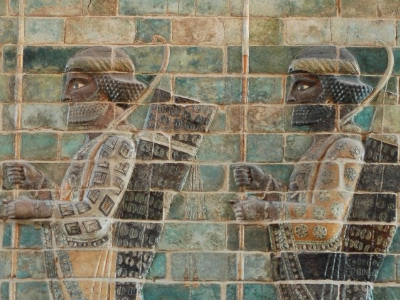Battle of Marathon (490 BC)

Background
The first Persian invasion of Greece had its immediate roots in the Ionian Revolt, the earliest phase of the Greco-Persian Wars. However, it was also the result of the longer-term interaction between the Greeks and Persians. In 500 BC the Persian Empire was still relatively young and highly expansionistic, but prone to revolts amongst its subject peoples. Moreover, the Persian King Darius was a usurper, and had spent considerable time extinguishing revolts against his rule. Even before the Ionian Revolt, Darius had begun to expand the empire into Europe, subjugating Thrace, and forcing Macedon to become a vassal of Persia. Attempts at further expansion into the politically fractious world of ancient Greece may have been inevitable. However, the Ionian Revolt had directly threatened the integrity of the Persian empire, and the states of mainland Greece remained a potential menace to its future stability. Darius thus resolved to subjugate and pacify Greece and the Aegean, and to punish those involved in the Ionian Revolt.
The Ionian Revolt had begun with an unsuccessful expedition against Naxos, a joint venture between the Persian satrap Artaphernes and the Milesian tyrant Aristagoras. In the aftermath, Artaphernes decided to remove Aristagoras from power, but before he could do so, Aristagoras abdicated, and declared Miletus a democracy. The other Ionian cities followed suit, ejecting their Persian-appointed tyrants, and declaring themselves democracies. Aristagoras then appealed to the states of mainland Greece for support, but only Athens and Eretria offered to send troops.
The involvement of Athens in the Ionian Revolt arose from a complex set of circumstances, beginning with the establishment of the Athenian Democracy in the late 6th century BC.
In 510 BC, with the aid of Cleomenes I, King of Sparta, the Athenian people had expelled Hippias, the tyrant ruler of Athens. With Hippias's father Peisistratus, the family had ruled for 36 out of the previous 50 years and fully intended to continue Hippias's rule. Hippias fled to Sardis to the court of the Persian satrap, Artaphernes and promised control of Athens to the Persians if they were to help restore him. In the meantime, Cleomenes helped install a pro-Spartan tyranny under Isagoras in Athens, in opposition to Cleisthenes, the leader of the traditionally powerful Alcmaeonidae family, who considered themselves the natural heirs to the rule of Athens. Cleisthenes, however, found himself being politically defeated by a coalition led by Isagoras and decided to change the rules of the game by appealing to the demos (the people), in effect making them a new faction in the political arena. This tactic succeeded, but the Spartan King, Cleomenes I, returned at the request of Isagoras and so Cleisthenes, the Alcmaeonids and other prominent Athenian families were exiled from Athens. When Isagoras attempted to create a narrow oligarchic government, the Athenian people, in a spontaneous and unprecedented move, expelled Cleomenes and Isagoras. Cleisthenes was thus restored to Athens (507 BC), and at breakneck speed began to reform the state with the aim of securing his position. The result was not actually a democracy or a real civic state, but he enabled the development of a fully democratic government, which would emerge in the next generation as the demos realized its power. The new-found freedom and self-governance of the Athenians meant that they were thereafter exceptionally hostile to the return of the tyranny of Hippias, or any form of outside subjugation, by Sparta, Persia, or anyone else.
Cleomenes was not pleased with events, and marched on Athens with the Spartan army. Cleomenes's attempts to restore Isagoras to Athens ended in a debacle, but fearing the worst, the Athenians had by this point already sent an embassy to Artaphernes in Sardis, to request aid from the Persian empire. Artaphernes requested that the Athenians give him an 'earth and water', a traditional token of submission, to which the Athenian ambassadors acquiesced. They were, however, severely censured for this when they returned to Athens. At some later point Cleomenes instigated a plot to restore Hippias to the rule of Athens. This failed and Hippias again fled to Sardis and tried to persuade the Persians to subjugate Athens. The Athenians dispatched ambassadors to Artaphernes to dissuade him from taking action, but Artaphernes merely instructed the Athenians to take Hippias back as tyrant. The Athenians indignantly declined, and instead resolved to open war with Persia. Having thus become the enemy of Persia, Athens was already in a position to support the Ionian cities when they began their revolt. The fact that the Ionian democracies were inspired by the example the Athenians had set no doubt further persuaded the Athenians to support the Ionian Revolt, especially since the cities of Ionia were originally Athenian colonies.
The Athenians and Eretrians sent a task force of 25 triremes to Asia Minor to aid the revolt. Whilst there, the Greek army surprised and outmaneuvered Artaphernes, marching to Sardis and burning the lower city. This was, however, as much as the Greeks achieved, and they were then repelled and pursued back to the coast by Persian horsemen, losing many men in the process. Despite the fact that their actions were ultimately fruitless, the Eretrians and in particular the Athenians had earned Darius's lasting enmity, and he vowed to punish both cities. The Persian naval victory at the Battle of Lade (494 BC) all but ended the Ionian Revolt, and by 493 BC, the last hold-outs were vanquished by the Persian fleet. The revolt was used as an opportunity by Darius to extend the empire's border to the islands of the eastern Aegean and the Propontis, which had not been part of the Persian dominions before. The pacification of Ionia allowed the Persians to begin planning their next moves; to extinguish the threat to the empire from Greece and to punish Athens and Eretria.
In 492 BC, after the Ionian Revolt had finally been crushed, Darius dispatched an expedition to Greece under the command of his son-in-law, Mardonius. Mardonius re-subjugated Thrace and made Macedonia a fully subordinate part of the Persians; they had been vassals of the Persians since the late 6th century BC, but retained their general autonomy. Not long after however, his fleet became wrecked by a violent storm, which brought a premature end to the campaign. However, in 490 BC, following the successes of the previous campaign, Darius decided to send a maritime expedition led by Artaphernes, (son of the satrap to whom Hippias had fled) and Datis, a Median admiral. Mardonius had been injured in the prior campaign and had fallen out of favor. The expedition was intended to bring the Cyclades into the Persian empire, to punish Naxos (which had resisted a Persian assault in 499 BC) and then to head to Greece to force Eretria and Athens to submit to Darius or be destroyed. After island-hopping across the Aegean, including successfully attacking Naxos, the Persian task force arrived off Euboea in mid summer. The Persians then proceeded to besiege, capture and burn Eretria. They then headed south down the coast of Attica, en route to complete the final objective of the campaign—punish Athens.
HISTORY

RESOURCES
This article uses material from the Wikipedia article "Battle of Marathon (490 BC)", which is released under the Creative Commons Attribution-Share-Alike License 3.0.
© Stories Preschool. All Rights Reserved.









